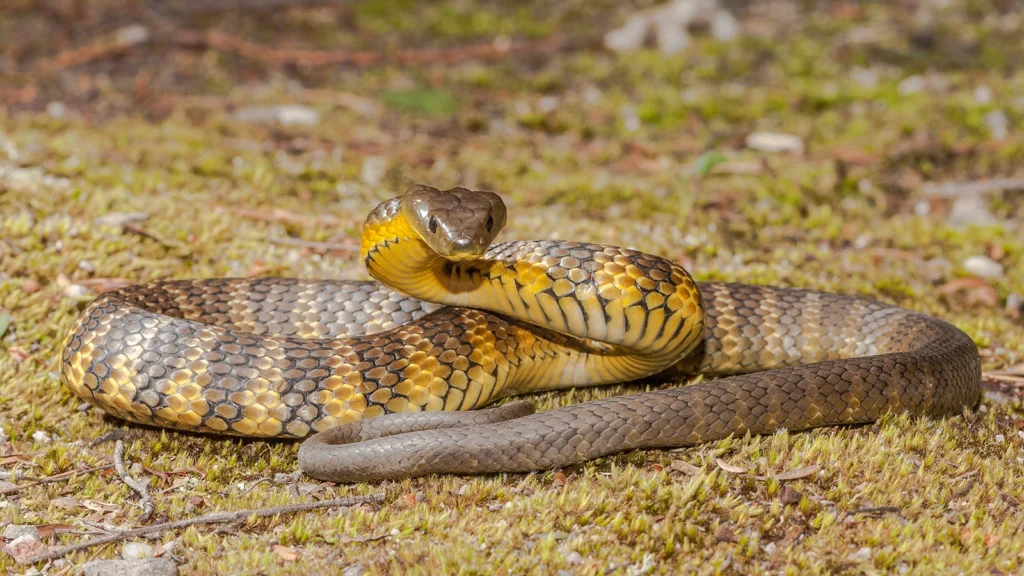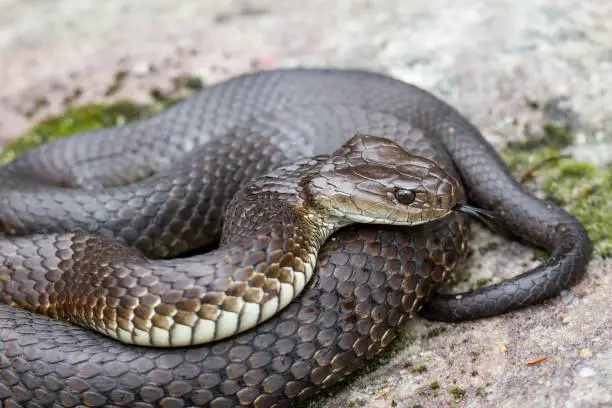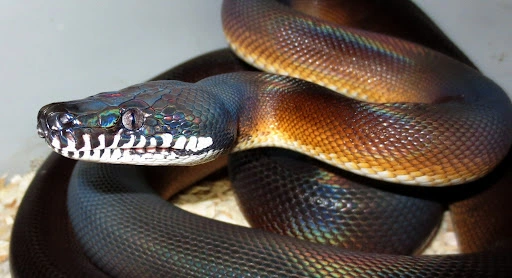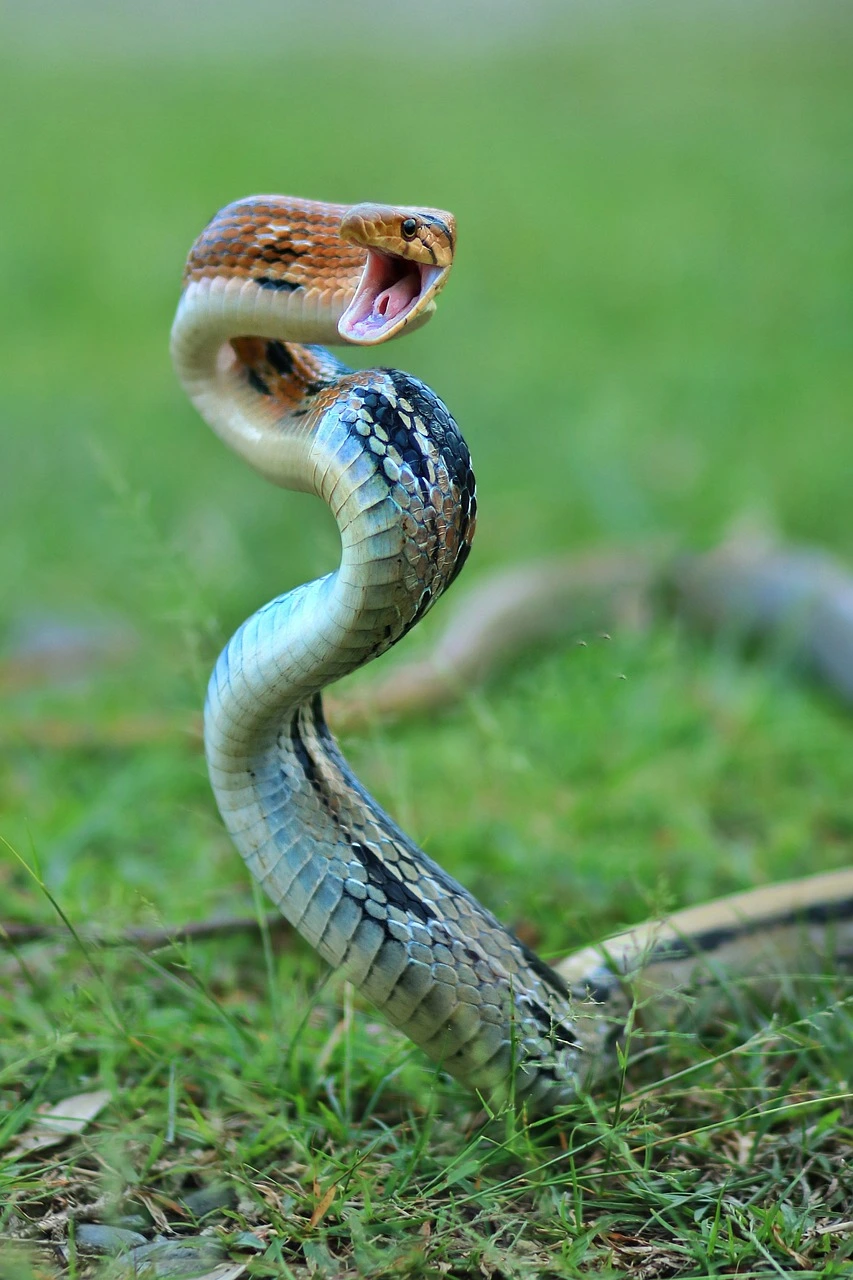many nature lovers and adventurers each year. However, a question often arises for visitors and even some locals: Are there snakes in Tasmania? The answer is yes. Tasmania is home to a small but fascinating collection of snake species, all of which are venomous. In this article, we’ll cover which snakes inhabit Tasmania, what to expect if you encounter one, and practical advice for staying safe while exploring the outdoors.
Are there snakes in Tasmania?
Yes, Tasmania has snakes, although it hosts only three native species, all of which are venomous: the Tiger Snake (Notechis scutatus), Lowland Copperhead (Austrelaps superbus), and White-lipped Snake (Drysdalia coronoides). These snakes are well-adapted to the island’s unique climates and landscapes, from coastal areas to dense forests.
What Types of Snakes Are Found in Tasmania?
As mentioned before, there are only three known species of snake that can be found and encountered in Tasmania. The tiger snake, lowland copperhead and white-lipped snake are the trifecta of snakes found in Tasmania. Allow me to explain in more detail:
1. Tiger Snake (Notechis scutatus)

- Appearance: As for tiger snakes that are present in Tasmania, they can be either dark brown or olive, sometimes even black. And some sport patterns that look like tiger cross stripes or bands.
- Size: The average growth is around between 1.2 meters to about 1.8 metres.
- Habitat: Generally prefers to be found near wetlands, grasslands and rivers or ponds.
- Venom: The tiger snake is extremely venomous, in fact, amongst other snakes it is known to be a high level threat.
- Diet: The tiger snake would most likely eat frogs, small animals or through some passes in birds.
2. Lowland Copperhead (Austrelaps superbus)

- Appearance: The average coloration is considered to be coppery and brownish. Yellow and black variants are also in the population.
- Size: The typical Lowland Copperhead measures from 1 to 1.5 meters in length.
- Habitat: As much as their range extends to include grasslands, Austrelaps superbus likes to remain within moist areas which are close to water.
- Venom: It is venomous although naturally timid and avoiding contact with humans is its characteristic behaviour.
- Diet: Lowland Copperhead feeds off amphibians, small mammals alongside other members of the reptile family.
3. White-lipped Snake (Drysdalia coronoides)

- Appearance: Slenderness and diminutive size characterize the species together with cool grey or olive green color and white lip variations.
- Size: Known to be the shortest breed of snake that can grow between 40 to 60 centimeters long.
- Habitat: It has found its home in dry forests, heathlands and is likely to be in cooler areas that are less dry.
- Venom: It is slightly toxic, won’t inflict too much damage but it’s not as easy to counter as others.
- Diet: Smaller lizards and insects are the two prominent diets of Drysdalia coronoides.
Snake Activity and Seasonal Patterns
In Tasmania, snakes come to life throughout the months of October to March, the warmest months of the year. During this time span, they begin to migrate from hibernation in search for sunlight, food and to reproduce. To escape the cold weather, snakes tend to look for warm and secluded areas to hide, this includes empty tree branches, rock piles and other secretive areas.
Key Points to Remember About Seasonal Snake Behaviour:
- Spring Emergence: The time to emerge out of hibernation, snakes begin to increase their activity so that they can find food and reproduce.
- Breeding and Birthing: The hayday of tiger snakes and copperheads as they often give birth to live young, the times when white-lipped snakes have smaller births.
- Hibernation Habits: A time period of great dread as snakes go into torpor and spend the rest of winter snoozing in a dry and warm space until the next spring season arrives.
Safety Tips for Avoiding Snake Encounters in Tasmania
Snakes in Tasmania can be venomous; however, human interaction is fairly uncommon and can be avoided while taking extra precautions. Here are some important pieces of advice:
When Outdoors
- Stay on Paths: Try to stick to paths that are not covered with green vegetation that snakes may be lurking around. Avoid walking in dense plant areas.
- Wear Protective Clothing: Adding on to my notice while placing a counter to the elements all around the perimeter, we need to keep sturdy boots and long pants as a precautionary measure.
- Be Aware of Your Surroundings: While in Caves, be careful where you put your foot forward and refrain from dipping your hand one inch into a gauge where examination has not taken place.
At Home
- Snake-proof Your Yard: Yards that are housed with tall grass, debris and shrubs are prime snake living properties. The best prevention for this would consist of fencing your yard from incoming snakes.
- Secure Pets: Snakes tend to hang out in big bushes and piles of woods. Make sure your pets don’t wander around too much, particularly your dogs.
- Seal Entry Points: Make sure all the windows and doors on a building are fully pulled shut and minimize the clutter around the house as it could serve a snake as camping grounds.
What to Do if You Encounter a Snake
Seeing a snake, if this is your first time, it can be pretty shocking but know that there are protective measures in place as long as keeping your calm is the top priority. Here’s a process of what to do if you see one:
- Stay Calm: Sustaining a “face off” encounter with a snake is not the wisest decision. Avoid the confrontation and chances are it will make a run for it.
- Back Away Slowly: No matter how unsettling it is, don’t scare or provoke the snake. A skittish snake is one more reason for me to gently back away and make a sly exit.
- Don’t Attempt to Handle or Harm the Snake: Snake attacks often result when attempts are made by individuals to grab a snake or try to kill it. Avoid Handling It Yourself.
- Keep Children and Pets Away: As much as possible, remove children and pets from the reach of the snake.
- Call a Professional: For help, reach out to a certified snake handler or your nearest wildlife service if there’s a snake in your house or a threat can be caused by a snake.
How to Respond to a Snake Bite
Snake bites are uncommon but when one occurs the knowledge of first aid can prove quite useful in the hours to come.
- Apply a Pressure Bandage: Start above the area of the wound and placing a bandage and wrapping it around the bite site will keep the venom from spreading throughout the body’s lymphatic system.
- Immobilise the Limb: Avoid unnecessary movements of the limb in use.
- Seek Immediate Medical Attention: Find the nearest hospital that offers antivenom emergency assistance and make sure you contact emergency services beforehand. Especially tiger snakes are the prominent type of snake in Tasmania so the medical facilities are well prepared to handle snake bites.
The Importance of Snakes in Tasmania’s Ecosystem
Tasmania’s snakes are often a subject of fear and intimidation; however, they are one of the major reasons for maintaining the ecological equilibrium of the island:
- Pest Control: The snakes are vital in limiting the number of rodents, frogs and smaller mammals, hence limiting the usage of dangerous pesticides.
- Prey for Larger Animals: In Tasmania, certain birds and other predators depend on snakes in order to survive; hence, snakes’ contribution to the food web as a whole is significant.
- Indicators of Environmental Health: Snakes being the predators are very sensitive to changes occurring in the environment; hence, their presence even indicates that the ecosystem is in equilibrium.
Conservation Status and Legal Protection
Due to their heightened recognition within the ecosystem, Tasmanian snakes are afforded legal protection by the state. As snakes in Tasmania suffer from habitat loss due owing to land clearing coupled with the encroaching urban development, understanding their habitat has become pivotal since they are being pushed slowly to urban centers.
Debunking Common Myths About Tasmanian Snakes
Factual information of snakes can help lessen the fear they incite and promote safe cohabitation:
Myth: People believe that Tasmanian snakes are out for blood and will follow you for it.
- Fact: Snakes bare much shyness and will avoid coming in contact with humans, hence aggression is seldom shown. More so, aggression is only shown when people are overly defensive.
Myth: Many adults feel that it’s only older snakes which should be feared.
- Fact: Young snakes aren’t any less venomous than adult snakes, even if they are less capable of producing enough venom.
Myth: Snakes commonly are found within houses.
- Fact: A snake bite, though rare, can occur when snakes enter houses to find a warm place to hide or look for food. However, one can also ensure that this does not happen by blocking access points .
Conclusion: Coexisting with Tasmania’s Snakes
Yes, Tasmania does have snakes, but with awareness and respect for these reptiles, residents and visitors can coexist with them safely. Snakes play a vital role in the Tasmanian ecosystem, helping control pest populations and supporting biodiversity. By following the safety tips and understanding their behaviours, you can enjoy Tasmania’s natural beauty without worry. Remember, Tasmania’s snakes are a part of what makes the island’s wildlife unique and fascinating.
Read also: Are Kumho Tyres Good for Australian Roads






